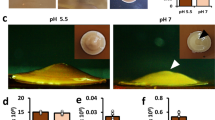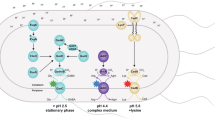Abstract
Stress response to fluctuating environments often implies a time-consuming reprogramming of gene expression. In bacteria, the so-called bet hedging strategy, which promotes phenotypic stochasticity within a cell population, is the only fast stress response described so far1. Here, we show that Caulobacter crescentus asymmetrical cell division allows an immediate bimodal response to a toxic metals-rich environment by allocating specific defence strategies to morphologically and functionally distinct siblings. In this context, a motile swarmer cell favours negative chemotaxis to flee from a copper source, whereas a sessile stalked sibling engages a ready-to-use PcoAB copper homeostasis system, providing evidence of a prompt stress response through intrinsic bacterial dimorphism.
This is a preview of subscription content, access via your institution
Access options
Subscribe to this journal
Receive 12 digital issues and online access to articles
$119.00 per year
only $9.92 per issue
Buy this article
- Purchase on Springer Link
- Instant access to full article PDF
Prices may be subject to local taxes which are calculated during checkout




Similar content being viewed by others
References
Veening, J. W., Smits, W. K. & Kuipers, O. P. Bistability, epigenetics, and bet-hedging in bacteria. Annu. Rev. Microbiol. 62, 193–210 (2008).
Cannon, W. B. Bodily Changes in Pain Hunger Fear and Rage (D. Appleton & Co., 1920).
Osman, D. & Cavet, J. S. Copper homeostasis in bacteria. Adv. Appl. Microbiol. 65, 217–247 (2008).
Bagwell, C. E., Milliken, C. E., Ghoshroy, S. & Blom, D. A. Intracellular copper accumulation enhances the growth of Kineococcus radiotolerans during chronic irradiation. Appl. Environ. Microbiol. 74, 1376–1384 (2008).
Palumaa, P. Copper chaperones. The concept of conformational control in the metabolism of copper. FEBS Lett. 587, 1902–1910 (2013).
Ma, Z., Jacobsen, F. E. & Giedroc, D. P. Metal transporters and metal sensors: how coordination chemistry controls bacterial metal homeostasis. Chem. Rev. 109, 4644–4681 (2009).
Rensing, C. & Grass, G. Escherichia coli mechanisms of copper homeostasis in a changing environment. FEMS Microbiol. Rev. 27, 197–213 (2003).
Outten, F. W., Outten, C. E., Hale, J. & O'Halloran, T. V. Transcriptional activation of an Escherichia coli copper efflux regulon by the chromosomal MerR homologue, cueR. J. Biol. Chem. 275, 31024–31029 (2000).
Outten, F. W., Huffman, D. L., Hale, J. A. & O'Halloran, T. V. The independent Cue and Cus systems confer copper tolerance during aerobic and anaerobic growth in Escherichia coli. J. Biol. Chem. 276, 30670–30677 (2001).
Stoyanov, J. V., Hobman, J. L. & Brown, N. L. CueR (YbbI) of Escherichia coli is a MerR family regulator controlling expression of the copper exporter CopA. Mol. Microbiol. 39, 502–511 (2001).
Fang, G. et al. Transcriptomic and phylogenetic analysis of a bacterial cell cycle reveals strong associations between gene co-expression and evolution. BMC Genomics 14, 450 (2013).
Skerker, J. M. & Laub, M. T. Cell-cycle progression and the generation of asymmetry in Caulobacter crescentus. Nature Rev. Microbiol. 2, 325–337 (2004).
Lee, S. M. et al. The Pco proteins are involved in periplasmic copper handling in Escherichia coli. Biochem. Biophys. Res. Commun. 295, 616–620 (2002).
Jacobs, C., Hung, D. & Shapiro, L. Dynamic localization of a cytoplasmic signal transduction response regulator controls morphogenesis during the Caulobacter cell cycle. Proc. Natl Acad. Sci. USA 98, 4095–4100 (2001).
Jacobs, C., Ausmees, N., Cordwell, S. J., Shapiro, L. & Laub, M. T. Functions of the CckA histidine kinase in Caulobacter cell cycle control. Mol. Microbiol. 47, 1279–1290 (2003).
Reichelt, M., von Specht, B. U. & Hahn, H. P. The Caulobacter crescentus outer membrane protein Omp58 (RsaF) is not required for paracrystalline S-layer secretion. FEMS Microbiol. Lett. 201, 277–283 (2001).
Huffman, D. L. et al. Spectroscopy of Cu(ii)-PcoC and the multicopper oxidase function of PcoA, two essential components of Escherichia coli Pco copper resistance operon. Biochemistry (Moscow) 41, 10046–10055 (2002).
Fernandez-Fernandez, C., Grosse, K., Sourjik, V. & Collier, J. The β-sliding clamp directs the localization of HdaA to the replisome in Caulobacter crescentus. Microbiol. Read. Engl. 159, 2237–2248 (2013).
Oakley, A. J. et al. Flexibility revealed by the 1.85 A crystal structure of the beta sliding-clamp subunit of Escherichia coli DNA polymerase III. Acta Crystallogr. D 59, 1192–1199 (2003).
Hiniker, A., Collet, J.-F. & Bardwell, J. C. A. Copper stress causes an in vivo requirement for the Escherichia coli disulfide isomerase DsbC. J. Biol. Chem. 280, 33785–33791 (2005).
Macomber, L. & Imlay, J. A. The iron–sulfur clusters of dehydratases are primary intracellular targets of copper toxicity. Proc. Natl Acad. Sci. USA 106, 8344–8349 (2009).
Py, B., Moreau, P. L. & Barras, F. Fe–S clusters, fragile sentinels of the cell. Curr. Opin. Microbiol. 14, 218–223 (2011).
Hallez, R., Bellefontaine, A.-F., Letesson, J.-J. & De Bolle, X. Morphological and functional asymmetry in α-proteobacteria. Trends Microbiol. 12, 361–365 (2004).
Deghelt, M. et al. G1-arrested newborn cells are the predominant infectious form of the pathogen Brucella abortus. Nature Commun. 5, 4366 (2014).
Poindexter, J. S. Selection for nonbuoyant morphological mutants of Caulobacter crescentus. J. Bacteriol. 135, 1141–1145 (1978).
Ely, B. in Methods in Enzymology Vol. 204 (ed. Miller, J. H. ) 372–384 (Academic, 1991).
Evinger, M. & Agabian, N. Envelope-associated nucleoid from Caulobacter crescentus stalked and swarmer cells. J. Bacteriol. 132, 294–301 (1977).
Winzeler, E. & Shapiro, L. Use of flow cytometry to identify a Caulobacter 4.5 S RNA temperature-sensitive mutant defective in the cell cycle. J. Mol. Biol. 251, 346–365 (1995).
Levi, A. & Jenal, U. Holdfast formation in motile swarmer cells optimizes surface attachment during Caulobacter crescentus development. J. Bacteriol. 188, 5315–5318 (2006).
Le Blastier, S. et al. Phosphate starvation triggers production and secretion of an extracellular lipoprotein in Caulobacter crescentus. PLoS ONE 5, e14198 (2010).
Achard, M. E. S. et al. The multi-copper-ion oxidase CueO of Salmonella enterica serovar Typhimurium is required for systemic virulence. Infect. Immun. 78, 2312–2319 (2010).
Acknowledgements
The authors thank C. Jacobs-Wagner, J. Collier, L. Shapiro, P. Viollier and J. Smit for providing strains and antibodies. The authors acknowledge the microscopy platform of the De Duve Institute (UCL) for allowing access to the Zen Observer Z.1 inverted microscope, and thank C. Staudt (URPhym, UNamur) for technical support regarding the oxygraph and R. Stephan from the GIGA Flow Cytometry Facility (ULg) for technical support with FACS cell counting. Finally, the authors thank C. Jacobs-Wagner, J.-F. Collet, G. Cornelis and X. De Bolle for critical reading of the manuscript and the URBM members for discussions. This work was supported by the University of Namur. E.L. and S.G. were supported by the Belgian Fund for Industrial and Agricultural Research Associate (FRIA).
Author information
Authors and Affiliations
Contributions
E.L., S.G., G.L., F.T., S.L.B. and P.C. performed the experiments. E.L., S.G. and G.L. analysed the data. E.L. and J.-Y.M. initiated and designed the research. E.L., S.G. and J.-Y.M. wrote the manuscript.
Corresponding author
Ethics declarations
Competing interests
The authors declare no competing financial interests.
Supplementary information
Supplementary Information
Supplementary Figures 1-15, Supplementary Text, Supplementary Tables 1 and 2, Supplementary References (PDF 27626 kb)
Rights and permissions
About this article
Cite this article
Lawarée, E., Gillet, S., Louis, G. et al. Caulobacter crescentus intrinsic dimorphism provides a prompt bimodal response to copper stress. Nat Microbiol 1, 16098 (2016). https://doi.org/10.1038/nmicrobiol.2016.98
Received:
Accepted:
Published:
DOI: https://doi.org/10.1038/nmicrobiol.2016.98
This article is cited by
-
Unique underlying principles shaping copper homeostasis networks
JBIC Journal of Biological Inorganic Chemistry (2022)



